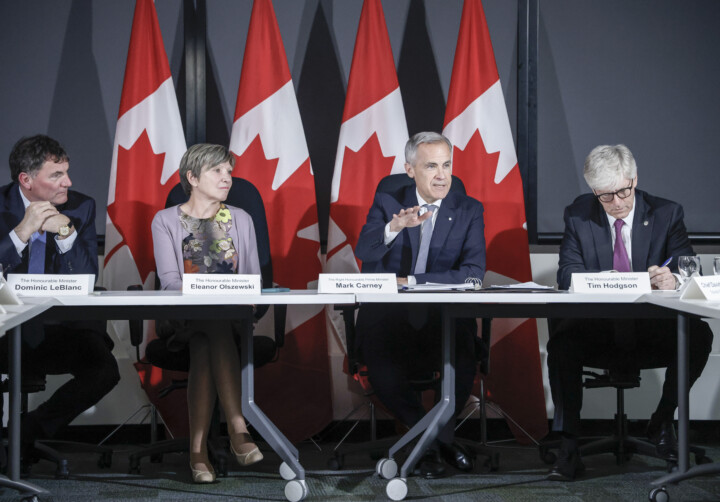Rumours are swirling around Ottawa that Mark Carney will call an election days after becoming Liberal leader, causing the next election to take place before the end of April. If true, this does not give an incoming government much time to develop a plan to address Canada’s middle-class housing affordability crisis, particularly given that Canada-U.S. relations will be the all-consuming preoccupation.
But Canada cannot afford to ignore its housing crisis. The federal government must find measures that are straightforward to design and implement. They can do so by focusing on five key middle-class housing priorities.
1. Implement a generous GST rebate
Priority number one should be lowering taxes on new housing construction as much as possible. While almost all these taxes are assessed by provincial, regional, and municipal governments, a notable exception is the Goods and Services Tax (GST). Because the federal GST is only assessed on new housing, it acts as a tax on new development that is applied on top of other housing construction taxes, like municipal development charges.
The Poilievre Conservatives have proposed eliminating the GST on all homes under $1 million, saving homebuyers up to $50,000 on the price of a new home. Mark Carney has proposed a similar measure, though it’s limited to first-time buyers. It’s a half-measure that excludes important groups, such as seniors downsizing into a small home. However, both of these plans suffer from the design flaw that the rebate immediately falls to $0 once a home crosses the million-dollar threshold. In most of the country, this design quirk is not much of a problem, but in pricey greater Toronto or greater Vancouver, it means that almost no new family-sized homes are eligible.
Instead, the next government should set a maximum rebate at $50,000, to ensure that homes priced over $1 million are still eligible for a partial GST rebate. In Ontario, residents buying a new home receive a provincial sales tax rebate to a maximum of $24,000. Taking this “plateau” approach rather than the “fiscal cliff” approach found in the proposals above would be far more beneficial to Canadians looking for a place to live.
2. Name and shame cities that keep housing costs high
A second priority should be holding provinces and municipalities accountable through increased transparency. One potential drawback to a GST cut on new housing is that provinces or municipalities may respond by increasing new housing taxes, capturing the cut for themselves rather than passing it along to new homebuyers.
The federal government has attempted to counteract this through measures such as the Housing Accelerator and the Canada Housing Infrastructure Fund, which places conditions on municipalities in exchange for federal money. Unfortunately, municipalities are choosing to forego the money rather than accept the conditions. Meanwhile, the federal government is finding it challenging to create a system that works across the entire country.
Nevertheless, these efforts, along with Poilievre’s Bill C-356 conditions tying infrastructure funding to housing outcomes, are still worth pursuing, despite their challenges. There are other less costly options the federal government could pursue. One cost-effective option would be to have either Statistics Canada or the Canadian Mortgage and Housing Corporation (CMHC) publish monthly data on development charges and other municipal taxes brought forward by Canada’s larger municipalities. Doing so would publicly name and shame municipalities that are hiking housing taxes and fees and reward those who keep costs low.
3. Revisit foreign investment bans
Third, governments must realize that industry is going to have to invest over $1 trillion to build enough homes by 2030. And this capital has to come from somewhere.
Existing programs, such as the CMHC’s Apartment Construction Loan Program can be expanded at little to no cost, thanks to the interest generated from these loans. Reintroducing the MURB program (which allowed investors to claim depreciation and some other costs of an apartment building against unrelated income) to incentivize domestic investment into apartment construction should be considered, although it certainly would not be easy to design and implement.
Given the sheer volume of investment dollars needed, the federal government must recognize that much of this money is going to have to come from outside Canada. As such, existing measures that disincentivize, or outright ban, foreign investment in new housing construction should be eliminated, though ones applying to U.S. investors could remain as part of Canada’s countermeasures to Trump tariffs. While policies chasing foreign investment from Canadian real estate are popular, they have almost certainly contributed to the recent slowdown in condo construction.
4. Drop pesky housing tariffs
The ongoing trade dispute with the U.S. creates the need for Canada to diversify the markets where we source housing inputs, as well as increase domestic production of parts and supplies. Scaling up domestic production is vital, but it is also complex and time-intensive. However, governments can take immediate action to help diversify supply chains. Canada already places import tariffs on key housing-related inputs, such as bathtubs, unless they fall under one of our existing trade agreements. We should immediately eliminate most housing-related tariffs, which will help lower input costs and diversify supply chains for builders. This would also send a message to the rest of the world that Canada believes in the value of open markets and trade.
5. Sniff out government program glitches
The fifth priority should be creating coherence between federal government programs. For example, the current federal government has prioritized facilitating the construction of fourplexes, by making them a focus in the CMHC design catalogue, as well as making them a requirement for many municipalities under the Housing Accelerator Fund. However, dive a little deeper and you’ll find examples of misalignment. Many programs, including the CMHC’s MLI Select mortgage loan insurance program, as well as their Apartment Loan Construction Program (ACLP), require that projects have a minimum of five units. Either programs like the design catalogue and the Housing Accelerator should be prioritizing five or six-unit buildings, or MLI Select should lower their unit minimum from five to four.
The next government should track down these misalignments and correct them through simple policy tweaks. Housing plans cannot work if our programs are simultaneously incentivizing and disincentivizing the construction of a particular type of housing.
Looking ahead
It is understandable if Canada’s leaders are distracted by the immediately pressing questions of free trade and securing our sovereignty. But the housing crisis is still a crisis and not getting better. Canadians deserve a government with a proper plan to solve it. Let’s hope it’s an issue that’s front and centre during the next federal election.










